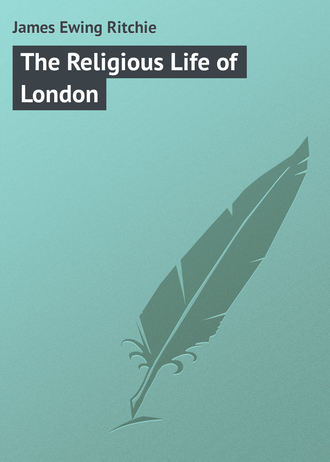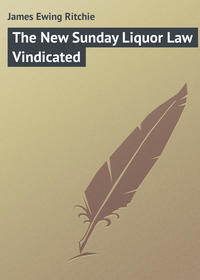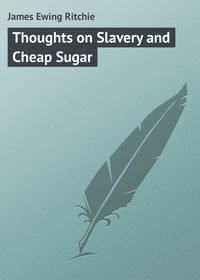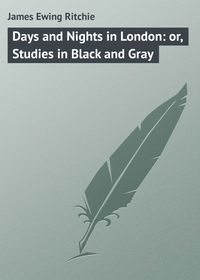 полная версия
полная версияThe Religious Life of London
whatever it was in Burns’s time, is a caricature of Presbyterianism as it exists in London in our day.
CHAPTER VIII.
congregationalists and baptists
Early in our religious history two theories as to Church and State were developed. If the Presbyterians had gained the day in that time of religious ferment – which had so melancholy a termination in the restoration of Charles II., with his puppy-dogs and mistresses – we should have seen the Church established independent of the State: the latter acting as its servant, exercising the sword at its bidding and on its behalf. The Churchmen of that day adopted a lower theory, as appears by their favourite formulas – “the power of the magistrate in ecclesiastical matters,” and “passive obedience without limitations.” In his zeal in this direction, Archbishop Sancroft actually went so far as to alter the rubric. If Bishop Cosin may be believed (the story is told by Calamy), where it was said nothing was to be read in the churches but by the Bishop’s order, Sancroft took on himself to add, “or the King’s order.” In short, the theory was then what Sir J. D. Coleridge only the other day stated it, that “the Church was a political institution.” Against this theory, as dishonouring to God and degrading to religion, the Puritans sternly protested, and at the peril of their lives. Naturally they fell back upon such texts as, “My kingdom is not of this world,” “Render unto Cæsar the things which are Cæsar’s, and to God the things that are God’s.” More and more it became clear to them that the Church was simply an assembly of believers; that Christ’s kingdom was exclusively a spiritual one; that the greatest service the State could do to religion was to leave it alone. They argued, and not without some show of plausibility, that the faith enunciated by the carpenter’s son, disseminated through the world by tent-makers and fishermen; the faith which had found its way into the hearts of the stubborn Jews; which had been more than a match for the pride of Rome or philosophy of Greece – for which the multitude, the grey-haired sire, the high-spirited lad with life with its golden prospects opening all round him, the tender and delicate maiden, had gone smilingly to die – the faith immortal with the immortality of truth, required not the vulgar patronage of worldly men, or that the State should attempt bribery on its behalf. Of course they were wrong; for only last session of Parliament the present Archbishop of Canterbury, in his place in the House of Lords, on the night of an important debate, denominated a religion thus supported as a spurious one; and it was only within the memory of living men that Nonconformists were permitted to be parish constables or town councillors. Nevertheless, half the worshippers of England and Wales are Dissenters – that is to say, are of this spurious religion, and pay their own ministers, and build their own chapels, without asking a farthing from the State. Their leading denominations are the Baptists and Congregationalists; and it shows how terribly Dissent undervalues the historical element when I state that the Independents now prefer to call themselves Congregationalists. There is an historical halo around Independency. Mr. Brodie remarks that “the grand principle by which the Independents surpassed all other sects was, universal toleration to all denominations of Christians whose religion was not conceived to be hostile to the peace of the State – a principle to which they were faithful in the height of power as well as under persecution.” Nor should it be forgotten that Locke, the first of our philosophers to argue on behalf of toleration, gained, as his biographers confess, his enlightened views from the Independent Divines.
Speaking relatively, Dissent is a thing of yesterday. It was born of the Puritanism which filled the gaols and fed the fires of Smithfield, when there were men and women ready to die for Christ and his Cross. Wycliffe was one of our earliest Dissenters. What he taught was the study of the Bible as the source of religious faith and the rule of a religious life. At college he was known as the Gospel doctor.
Queen Elizabeth ever believed in the invocation of saints; the worship of the Virgin Mary; thought it sinful for priests to marry, and had a couple of lighted candlesticks on her altar; but the country was full of learned divines, who had come from Geneva or Frankfort with a contempt for such papistical ideas, and with a more keen appreciation of the spiritual character of true religion. About twenty years after her accession, the principles of Independency were openly taught by Robert Brown, a relative of Cecil, the Lord Treasurer. When Black Bartholomew came, Puritans and Presbyterians were alike driven out of the Church. Owen, Vice-Chancellor of the University of Oxford, Baxter and Calamy, might have been Bishops, but they held that they could not assent to the teaching and ritualism of the Church, and be false to conscience and to God. For this they had to endure hardships, poverty, imprisonment, of all kinds – when Charles II., who obtained the Crown of England under false pretences, though he did, as Pepys tells us, take the Sacrament on his knees, received from his pliant Bishops his title of most religious King. Calamy, when a lad, wondered why the old ministers who led peaceable lives, and always prayed for the King, were persecuted, and in our day the feeling of wonder still exists.
There have been times when the religious life of England has been utterly divorced from the Church. Such were the times when George II. said all the Bishops were infidels; such were the times when the clergy read to their congregations the Book of Sports, enforcing on their hearers dancing, jumping, archery, Whitsun ales, May-poles, and Morrice dances on a Sunday; such were the times when the Methodists were expelled Oxford, and when old John Newton wrote, that besides himself, there were only two pious clergymen in London. It is impossible to overrate the obligations of this country to Dissent. It saved England from Popery. It laid the foundation of the mightiest republic the world has yet seen. It crushed the despotism of the Stuarts, while the Church was indecently declaring that a royal proclamation had the force of law. It gave us civil and religious liberty; the wonderful change for the better which within the last thirty years has come over the Church life of this country is due to the fact that, rivalling the Establishment in zeal and good works, has been an ever-growing, intelligent, and educated Dissent.
What are the doctrines of orthodox Dissenters? I reply, as regards Baptists and Congregationalists, they are very much the same. The real question at issue, whether adults or infants are the proper subjects of baptism, and whether the rite should be administered by baptism or immersion, really being but of little more importance than that of the Big Endians and the Little Endians of Gulliver. The Congregational Union issue a statement called “The Principles of Religion,” which they publish, not as a bond of union or as a series of articles to be subscribed to, but as a summary of what is commonly believed amongst them. In this document they state they believe the Scriptures of the Old Testament as received by the Jews, and the books of the New Testament as received by the Primitive Christians from the Evangelists and Apostles, to be divinely inspired and of divine authority; they believe in one God as revealed in the Scriptures as Father, Son, and Holy Spirit; in the fall of man; in the existence in man of “a fatal inclination to moral evil utterly incurable by human means;” in God, before the foundation of the world, designing the manifestation of his Son in the flesh for our salvation, to attain eternal salvation for us. They believe that the Holy Spirit is given to quicken and renew the soul of man; that all who will be saved were the objects of God’s electing and eternal love; in the perseverance of the Saints; in the perpetual obligation of baptism and the Lord’s Supper; in the coming of Christ to judge all flesh; that the righteous will receive life everlasting, and that the portion of the wicked will be everlasting punishment. As I have stated, such is a rough outline of the common belief in Congregational and Baptist Chapels. It is to be questioned, however, whether it would receive the unanimous assent and consent of Baptist and Congregational ministers.
As regards Church order and discipline, I may attempt the following summary, which I believe is as true of Baptist as of Congregational Churches.
A Church, according to them, is a society of believers meeting voluntarily together to observe religious ordinances; to promote mutual edification and holiness; to perpetuate and promulgate the Gospel in the world; and to advance the glory and worship of God through Jesus Christ. The New Testament exclusively is their authority for Church customs, and Christ is their only head; they elect their own officers, whether bishops or pastors, and deacons. They believe that no person should be received as members of Christian Churches but such as make a credible profession of Christianity; are living according to its precepts, and attest a willingness to be subject to its discipline. They believe that the power of a Christian is purely spiritual, and should in no way be corrupted by union with temporal or spiritual power.
In London there are 22 °Congregational churches and 210 Baptist; some of the latter being very small, and the ministers illiterate and narrow-minded more than is usually the case. The Congregationalists are chiefly incorporated in a body known as the Congregational Union, which meets twice a year to deliberate; once in London, and once in such provincial city or town as shall previously have been resolved on.
In London the Congregationalists have two or three Colleges for educating young men for the work of the Ministry – the principal one being the New College, St. John’s Wood. This College is in connexion with the London University, where some of the students graduate. The Baptists also have a fine College in the Regent’s Park, the students of which also occasionally are in the class lists of the London University. But the real fact is that in all the Dissenting Colleges the men who take university honours are the exception, not the rule; the reason is the course extends over but four or five years – and so much of that time is devoted to theological study and pulpit preparation that there is not the time to attain to the high standard prescribed by the London University. The student has often had but an average middle-class education. He feels an impulse, or, as it is technically termed, “a call” to the Ministry. He has been found acceptable as a Sunday School teacher, or in other ways has demonstrated his ability and religious character and zeal. With the sanction of his Minister and the Church with which he is connected, he is sent to College, where he remains till his professional education is complete. Occasionally young men seek to enter the Ministry with very humble views. Recently I heard of such a one. His pastor having indicated his doubt as to the possession of the requisite ability, the reply was: “Oh, sir, I know I never could be a learned man like you, but I thought I might make a hignorant Minister like Mr. – ,” naming a well-known and popular Minister of another denomination.
The Baptists have also their Baptist Union sitting in London, and occasionally in the Provinces. The first General (Arminian) Baptist Church is said to have been formed in London in 1607. The first Particular (Calvinistic) Church in 1616. I fancy that in some of the Baptist Bethels and Cave Adullams, an Antinomian, or, at any rate, a more decided Calvinism exists than prevails in the Independent Churches. As regards Church government, their ideas are the same. One necessity of this state of things is that their ministers must have some preaching ability, a thing which is quite an accident in the Church of England; another advantage is, that there are few pecuniary attractions to tempt men to undertake duties for which they are unqualified.
The leading bodies connected with Church work in London are as follows: – 1. The Congregational Chapel Building Society, of which the twentieth anniversary was held last year. We gather from the facts laid before the meeting that during the 21 years (including 1869) of the Society’s existence it has materially assisted in the erection or purchase of 87 chapels – representing a contribution from it in grants and free loans of 110,000l. towards an aggregate outlay of 360,000l., and providing (exclusive of intended galleries) nearly 80,000 sittings for adults. Dividing the 21 years of the Society’s history into three periods of seven years each, in the first period its list comprises 17 chapels, in the second 26, and in the third 44. The Society is at present engaged, with Mr. S. Morley, M.P., in the erection of 24 chapels, to each of which Mr. Morley contributes 500l., and the Society 500l., half of the last being free loans. The success of the Society is largely owing to its loan fund, now amounting to 11,006l. 19s., from which loans are made free of interest to committees engaged in the erection of chapels. This fund remains intact, and will be carefully preserved for the object. The grant fund is, however, just now nearly exhausted, while the liabilities of the Society on this account reach 2000l. Among other particulars, it may be stated that the Society has been instrumental in saving from extinction the two metropolitan chapels of George Whitefield – Tottenham Court Road Chapel, and the Tabernacle, Moorfields. Indeed, with the exception of Spa Fields Chapel, the Countess of Huntingdon’s followers may be said to be absorbed in the Congregational body.
The London Congregational Association has four District Missions. It has aided in planting and sustaining eight Churches and Missions in four districts. They ask 1000l. a year, with which, aided by local support, they undertake to plant ten new district Missions in spiritually destitute localities, and sustain them until they are enabled to support themselves. As an illustration of what may be done in this way I give the following account of the District Mission established by the Church and Congregation under the care of the Rev. Dr. Raleigh, of Hare Court Chapel, Canonbury, as drawn up by the Rev. J. H. Wilson, of the Home Missionary Society.
The parent Church selected necessitous districts, in which they have opened schools and mission-rooms; in these a number of the congregation begin to labour as teachers, visitors, evangelists, &c. The result is the early formation of a branch Church, where the poor people secure all the privileges of Christian fellowship, and the fine feeling of a Church-home, a place which they call “our Chapel,” and where they look up to some one whom they call “our pastor,” and soon those so gathered together become co-workers with the parent Church in extending its influence in the locality – rising out of these movements, the Church at Hare Court Chapel have now five branch Churches. From the last report (1868) it appears that there are now three rooms for religious service for the young, and several others for meetings with the poor and ignorant; three day schools, and five Sunday or ragged schools; two large week evening schools, and several smaller ones; seven mothers’ meetings; a district nursery for children and infants, whose mothers require to leave them during the day; coal clubs; home for little boys, where thirty are fed and clothed; three paid ministers; six lay evangelists or pastors; two Bible-women; six paid teachers, and seven paid monitors for day schools; and to aid them, there are from 300 to 400 members of the Church and congregation earnestly engaged as evangelists, pastors, teachers, helps, visitors, Scripture readers, &c. During the year about 120 had joined the Church. The Sunday and ragged schools are attended by 1300 children; the day schools by 900, and the evening schools by upwards of 400. Besides, there are temperance societies and Bands of Hope, and in the summer months out-door services.
Another society worked by the Congregationalists is the Christian Instruction Society, founded in the year 1825, to aid in evangelizing London. House-to-house visitation was from the beginning and still is its main characteristic. Its other agencies are lay-preaching in and out of doors; the Sunday afternoon opening of places of worship; lectures on prevailing immorality and vice, and united quarterly prayer meetings. This society, however, is by no means sectarian. At its united quarterly prayer meetings ministers of the Baptist, Presbyterian, and Independent denominations join.
THE SEVENTH-DAY BAPTISTS
As you go down Leman Street, Whitechapel, on your left, nearly at the bottom, stand two public-houses – one the Shamrock, the other, if I mistake not, the Brown Bear. Between them is a narrow little passage; on the right is a Gospel Hall, facing you is a plain brick-built Meeting-house, with a door which at certain times opens in vain, and with a window which is covered with wire of a very suggestive character. Above the window is an inscription, stating that it was rebuilt in 1790, but that it was founded more than a century before that. A side door leads you into a grass-grown and quiet enclosure. There are a few gravestones there, recording, in illegible characters, the piety and virtues of those who have gone before. At the back of the Meeting-house is the minister’s residence. In the same square resides the pew-opener, with her little family, who seem fresher and livelier than you would expect in such a place. Outside rush along the Fenchurch Street trains to and fro, sometimes with a scream which, as you will by-and-by find, will drown the preacher’s voice. Outside there are factories and warehouses darkening the air; outside there are heathens – baptized I daresay, but nevertheless heathens – as complete and entire as any discovered by Captain Cook; outside go up and down all day the sailors of every country under heaven, at all times when on shore a disorderly lot, with a strong tendency to get drunk and quarrel; outside are the lodging-house keepers, and Jew slop-sellers, and foul women and crimps, who lie in wait for poor Jack; outside, nightly and daily, on Sundays and week-days, once a week and all the year round, is the ever-deafening and ever-growing roar of London life.
On Saturdays this little old-fashioned meeting-house is opened twice a day. Of sects, as we all know, there are many Lilliputian varieties. One of the smallest of these is that of the Seventh-day Baptists. In this country there are two congregations of them; one in Mill Yard, and one far away in Gloucestershire, where, according to the common proverb, “God is.” At one time they were a sect, as they are I believe at this time in America. Here, in England, they have dwindled down to two skeleton congregations, an endowment, and a Chancery suit. As there is money a form of worship is kept up, though for all practical purposes the cause is dead. There may be four grown-up persons besides the pew-opener to form the morning service: there are just as many in the afternoon. There is no week-evening service. At one time, many, many years ago, there was a Sunday-school, but the scholars have grown up and moved away, and none have come to take their vacant places. Inside the door you are informed there are no pew-rents, no collections. Nevertheless, the people keep away. In the pulpit is a learned man of an old-fashioned and almost extinct type, and no one regards him; and yet I must confess there was to me a fascination in the place. It was the ghost of what I knew in youth. Long, long ago, there were just such old-fashioned meetings, with just such sounding-boards over the pulpit, just such plain and high pews, just such learned divines, just as deficient in all practical appeal. Up in the window before me buzzed the very same bluebottle fly, only a little more elderly and less active in consequence, which, in younger and happier days, distracted the writer’s attention, and interfered sadly with what would have been otherwise a profitable opportunity. There are no meeting-houses now. If you want to see one as they were, in all their original nakedness and want of grace, go to Mill Yard, Whitechapel. We, of course, have wonderfully improved, and yet I have a tenderness for the old meeting-house. How learned were their ministers, how awful and orthodox their deacons! With what fear did I eye the man who gave out the hymn, and with what greater fear the watchful individual who poked up with his long stick inattentive or sleepy boys!
But I return to Mill Yard. The Christian Church in our day has pretty well agreed to get rid of or, at any rate, ignore what is read in the Bible about the seventh day being “the Sabbath of the Lord your God.” At one time this was not so. Now the tide has receded and left the Seventh-day Baptists stranded on the mud. In doing so, the Church, of course, has increased the difficulty some feel about the Divine origin and perpetual obligation of the Christian Sabbath. Archbishop Whately, for instance, could reason with the Christian who had exchanged, in spite of the literal command of God, the Christian for the Jewish Sabbath, but his arguments would fail to touch the Seventh-day Baptist, who would contend that he was doing that which God had commanded. But the fear of this has not led Christians to abandon what, in the opinion of most of them, is the apostolic plan of meeting on the first day of the week. It is to be hoped the fund left for the benefit of the Seventh-day Baptists is not a large one. The mouldy appearance of Mill Yard Meeting-house indicates that it is not. But it is enough to retain at his post a gentleman who, perhaps, would be more profitably engaged elsewhere. Certainly it does seem like a waste of power to have a chapel and a service lasting nearly a couple of hours for one grown-up adult male and three adult females, excluding the chapel pew-opener. I must say, with the exception of a young gentleman in knickerbockers, who was so astonished at the apparition of a real stranger that he kept staring at me all the time of singing, all seemed to do their duty. The singing – and there was plenty of it – was really and truly Congregational. Five or six parts of the Bible were read, and the congregation followed with open Bibles. The preacher laboured at his discourse, and quoted Hebrew and Latin as if we had all been learned divinity students. Nor could he have prayed with more fulness and power had the benches been filled with living souls waiting to draw near to the Father of spirits and live. One could not but respect the preacher, however useless seemed his learning and misdirected his research. Yet I would be sorry to stand in his shoes. He had hearers once – Where are they? Dead, or moved away, is the reply. He says in 1840 he began “to officiate as afternoon preacher in the ancient Sabbath-keeping congregation in Mill Yard.” He talks of “nearly sixty years of close critical, philological, and exegetical study of the sacred Scriptures;” of “more than thirty years of constant and laborious exposition of them;” of his having fully, freely, fearlessly, and repeatedly discoursed upon every part of natural and revealed religion. In spite of his age, physically he is not unequal to his work. He has a good voice, yet practically he beats the air. There are few to listen to his words and respond to his appeal. I wonder – as in his quiet study he reads the ancient versions of the Bible and laboriously constructs his argument: – whether it ever occurs to him that there is something better and grander than seventh-day baptism, or systematic theology, and that is everyday Christianity. I wonder, too, while looking on the dead graves and the long grass, whether it occurs to him that in that region of all unclean and deadly sin it especially behoves the preacher, in preference to ingenious speculation or antiquarian research, to impress on the heart and consciences of men the yearning, living love of God. It is not in the calm retreat, the silent shade, that vice and irreligion can be confronted and changed into purity and piety. One would fancy at Mill Yard the contrary opinion was held, as the preacher goes on, expounding the Proverbs or the Book of Job to empty benches, while close by the harlot plies her unhallowed calling, the publican retails his vitriol gin, and mothers, with eyes artificially black, knock about their little ones or cover them with kisses, as they themselves are alcoholically stimulated into maudlin tenderness or demoniac rage! If you want to see what an endowment can do for religion, go to Mill Yard. No doubt those who left money for the place thought they were doing God service. In reality, an endowment can but preserve a corpse which had better be put away. We bury our dead out of our sight. As it is in the material world so it is in the spiritual world. We love to look on life; we shrink with abhorrence from the sight of death, when Time’s decaying fingers have dimmed the lustre of eyes once bright as stars, and plucked from beauty’s cheek the blushing rose.









